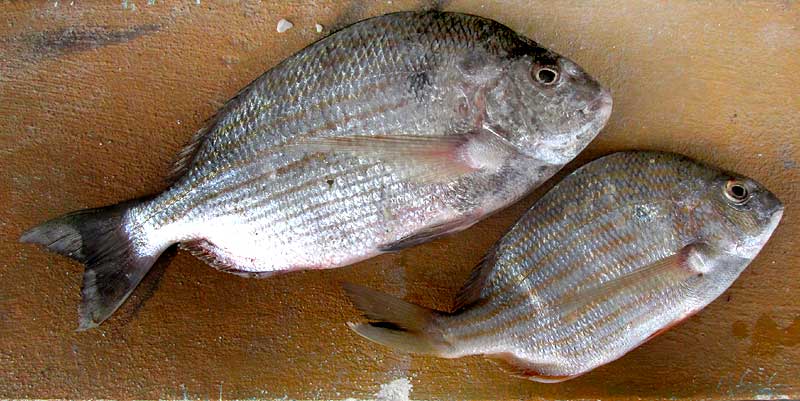Excerpts from Jim Conrad's
Naturalist Newsletter

from the January 4, 2015 Newsletter issued from Río Lagartos, on the Yucatan Peninsula's northern coast (~N21.60°, ~W88.16°), Yucatán state, MÉXICO
WESTERN ATLANTIC SEABREAM
My friend Chumas came trundling down the street on his bicycle holding a plastic bag of flattish, silvery, eight-inch-long (20cm) fish. He explained that he'd come to get his tour boat ready for a flamingo-viewing trip and had brought along the fish, which he called Sargo, to throw to pelicans so his guests could see how easily a pelican can gulp down such a fish. The Sargo, which bore faint, yellow lines along their lengths and curiously humped nose bridges, were "trash fish" a fisherman had thrown aside while emptying his net. I arranged the Sargo on a nearby concrete bench and got the above picture.
One place to identify Caribbean fish is the Snorkel St. John (Virgin Islands) website at http://www.snorkelstj.com/fish_gallery.html.
There, after clicking on "Fish with stripes," it was easy to spot Chumas's fish among the resulting thumbnails. They were what's often called Western Atlantic Seabream, ARCHOSARGUS RHOMBOIDALIS. Western Atlantic Seabream are described as populating mud bottoms in brackish mangrove sloughs and vegetated sand bottoms, both in brackish water and saltwater coral reef areas near mangroves. They feed on invertebrates such as small, clam-like bivalves and crustaceans, as well as on plant material. However, their diet is more complex than that:
A 1984 paper by Chavance and others entitled "Ecology, Biology and Population Dynamics of Archosargus rhomboidalis (Pisces, Sparidae) in a Tropical Coastal Lagoon System, Southern Gulf of Mexico" describes the Western Atlantic Seabream's life cycle in detail.
There it's explained that as the Western Atlantic Seabream develops from its larval stage to an adult, its diet passes through four stages, ranging from strictly carnivorous to omnivorous, and these changes are accompanied by other changes in mouth size, changing tooth alignment, or dentition, and changing habitat.
That paper describes Western Atlantic Seabream as commonly encountered but not exploited commercially, though it seems to have potential for being so. It's found from the US's Atlantic Coast at New Jersey south to Argentina, including the Caribbean.
Being such a landlubber, I wasn't sure how to pronounce "bream." The Cambridge Dictionaries Online website has the UK pronunciation rhyming with "steam" while the US version rhymes with "stem."